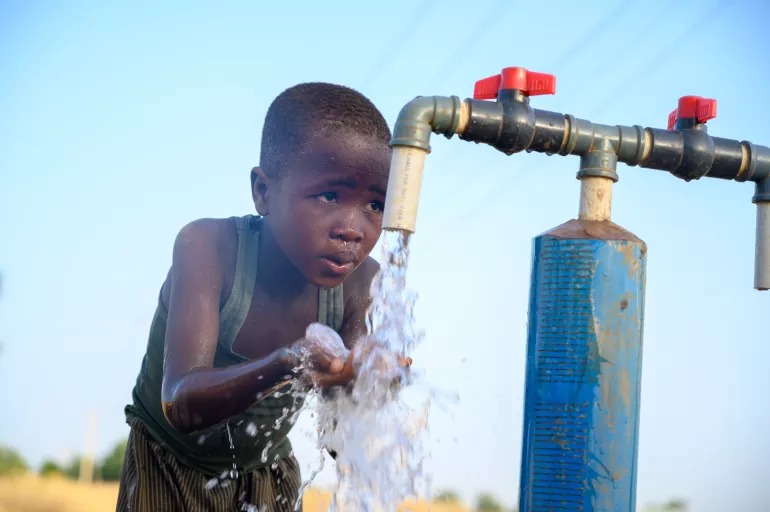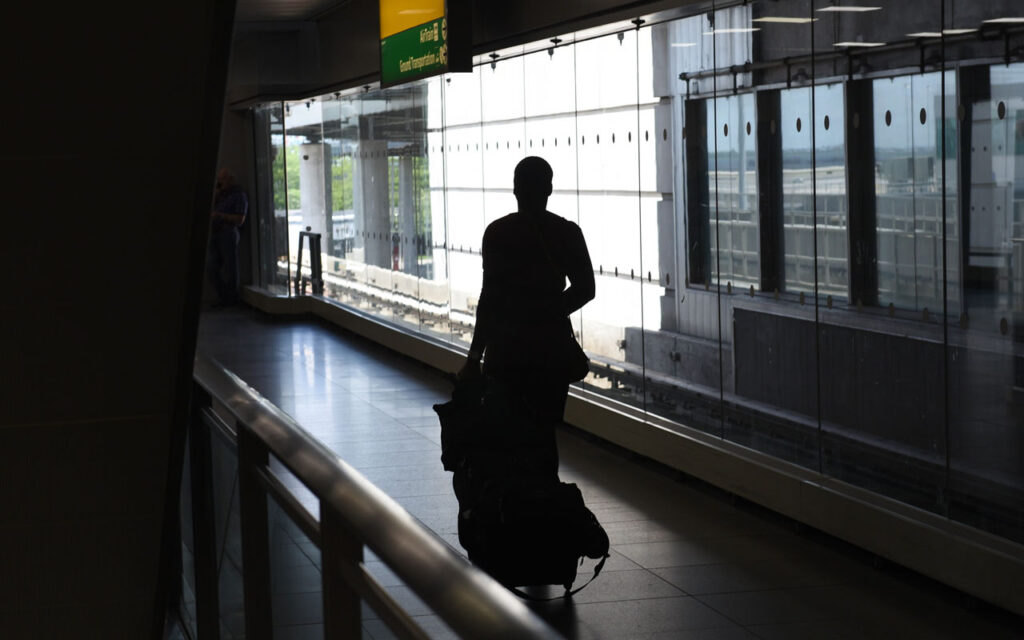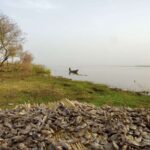
Inadequate access to water and poor water management practices majorly contribute to Nigeria’s inability to tame water insecurity. While approximately 70 million Nigerians do not have access to safe drinking water, water sources are frequently polluted with hazardous substances. Experts say implementing sound policies, existing trans-boundary water cooperation instruments, especially the Lake Chad and Niger and the UN Water Convention will curb water crisis in the country, CHINEDUM UWAEGBULAM writes
In September 2022, excessive water released from the LagdoReservoir (dam) in Cameroon, alongside continuous heavy rainfall, displaced about 1.4 million Nigerians from their homes, while about N700 billion worth of agricultural investments were lost.
The woes wrought by this ugly incident every rainy season, still linger in the minds of residents of flood-prone states like Taraba, Nasarawa, Anambra, Edo, Delta, Bayelsa, and Adamawa.
The floods, which periodically sweep across the banks of River Niger and River Benue down to the Atlantic Ocean in Bayelsa State emanate from the Lagdo Lake.
But despite the huge devastation caused by floods and excessive rainfalls, the attainment of water security in Nigeria remains a challenge, asunprecedented water scarcity crises have threatened people, including children who live in areas of high-water vulnerability.
By 2025, an estimated 1.8 billion people will live in areas plagued by water scarcity, with tow-thirds of the world’s population living in water-stressed regions as a result of use, growth, and climate change.
Not long ago, the African Ministers’ Council on Water (AMCOW) noted the urgent need to strengthen water security in Africa, and called for the adoption of a high-level framework of indicators to enable water security assessment.
However, to date, no specific framework for such an assessment has been proposed, and no assessment of water security for African countries is known to have been undertaken.
At the same time, water strongly underpins the social and economic development of the continent.
Africa’s population, currently around 1.37 billion people, is the fastest growing in the world. Its yearly growth rate currently exceeds 2.4 per cent, and is projected to remain above 2 per cent for the next 20 years. This population constitutes around 17 per cent of the global total, and is projected to reach nearly 40 per cent by 2100.
One of the characteristic features of Africa is a chronic lack of access to drinking water and sanitation. Indeed, over half of the 771 million people that lack basic drinking water around the world as at 2020 live in Africa. Again, of the two-thirds of people still lacking basic sanitation services in rural areas around the world, nearly half live in the region.
Water quality deterioration is a major threat among communities throughout Africa, and every hour, 115 people on the continent die from diseases linked to improper hygiene, poor sanitation, and contaminated water. Most wastewater generated by domestic, industrial, and mining activities remains untreated, and is released into freshwater bodies.
Estimates suggest that only around 16 per cent of wastewater produced in Africa undergoes any type of treatment.
Nigeria has many rivers that cover about 10,812,400 hectares, and therefore water security should be assured all things being equal, but the country is sadly burdened with an estimated 30 per cent dysfunctional status of newly provided water supply infrastructure within the first year of provision.
As of 2018, access to basic water supply services reached 67.9 per cent with 87.3 per cent for people living in urban areas and 59.7 per cent for those in rural areas, while about 70 million people lack access to improved drinking-water sources, with attendant high prevalence of water-borne diseases, threat to the livelihoods, and low levels of school enrolment, especially among girls.
Statistics also show that only about 70 per cent of Nigerians have access to basic water services, and more than half of these water sources are contaminated, while only nine litres of water is averagely available to a Nigerian daily.
The figures are particularly worrying, with 26.5 million Nigerian children experiencing high, or extremely high water vulnerability – or 29 per cent of Nigerian children.
At the current rate, the country will miss the Sustainable Development Goals (SDG) targets on people’s access to water, unless there is a strong commitment and appropriate action taken by all stakeholders.
While all can feel the impact of water scarcity, no one suffers more than the most vulnerable children. Children and families living in vulnerable communities face the double-edged sword of coping with high water scarcity levels, while having the lowest water services, making access to sufficient water especially susceptible to climate shocks and extreme events.
The Country Director, WaterAid Nigeria, Evelyn Mere, linked issues affecting water security in Nigeria to poor water stewardship by various stakeholders, governments not keeping updated data, enacting and implementing sound policies, over-abstraction, indiscriminate abstraction for commercial and domestic use, as well as, poor waste management, leading to pollution of surface water, poor sanitation that is endangering ground water quality.
She told The Guardian that climate change comes with extreme weather conditions, which lead to depleting ground water sources and aquifers. “Communities now must dig deeper boreholes before accessing water. Surface water is also shrinking due to siltation and drought. Higher temperatures are resulting in increases in seawater levels resulting in flooding that pollute water sources and saltwater intrusion.
“This reduces the availability of fresh water useful for human use and increases the risk of water insecurity as populations increase and migrations alter population patterns. The demand and competition for water intensifies with communities becoming water stressed.”
To ensure water security with the neighbouring countries, Mere said Nigeria must ensure the implementation of existing transboundary water cooperation instruments, especially the Lake Chad and Niger and the UN Water Convention.
“This can only be done by fulfilling her obligation and partnership with neighbouring countries to fulfill theirs. Water scarcity linked to climate change, pollution, and rising demands on their use is threatening these water bodies necessitating these partnerships.
“In-country, we need to adopt sound integrated water resources management policies and practices. This includes regulations of indiscriminate abstraction of groundwater sources by all stakeholders, protection of surface water sources from pollution and effective monitoring of water related data, inclusion quality climate change impacts.”
For Dr Joachim Ezeji, a water resources and ecosystem consultant, and founder of Rural Africa Water Development Project, setting a resilience agenda for water security in Nigeria would require the intentional implementation of water policies, enforcement of relevant laws and adoption of appropriate technology such as machineries, grey and green infrastructure, and other fixed assets.
“The use of laws and policies would enable relevant actions across all stakeholder groups, including nurturing and mapping sector expertise, change of attitude, behaviours and conducts.
“In a nutshell, in both Nigeria and across Africa, there is the need strengthen national, local governance and institutional arrangements for effective water security. There is also the need to align and update legal and policy frameworks and provide support to community-based ecosystem restoration.
Also, Ezeji told The Guardian that community-based reforestation interventions should be sustained, while diverse and alternative community-based livelihood strategies are established as a mitigate deforestation. We need a diversity of viable community-based enterprises supporting resilient livelihood strategies and climate change adaptation.
According to him, the structure and attributes of the Federal Ministry of Water Resources, and other water management agencies in the states, including the water utilities needs transformation, adding that “a work in this regard must include a detailed assessment of both. Even without the threat of climate change, there is the ever present need for water security. At least it ensures the graceful use of water. However, the risk of climate change makes water security a development agenda for Nigeria.”
Ezeji explained that the majority of territorially contiguous states in the country, and even parts of West and Central Africa, share both renewable, or nonrenewable surface and groundwater aquifers. It is, therefore, recognised that most states depend on rivers and/or aquifers that are shared with neighbouring states or other countriesfor their water supply.
“As shared surface water resources are becoming increasingly exhausted, in terms of quantity and/or quality, there is more and more reliance on shared groundwater resources, leading to their over-exploitation. A major challenge is thus confronting the country. Undisputedly, the sustainable management of this challenge is a desideratum.”
He stated that there is a significant variation in yearly average discharge, which has been observed since the 1970s in most rivers in West Africa, including the Niger River. Factors responsible for this decrease includes severe drought in the upper reaches of West Africa, water withdrawal and further water loses for evaporation from reservoir surfaces; the construction of the large reservoir of Kaiji (which resulted to a decrease by 20 per cent in the mean water discharge downstream), as well as the construction of a series of reservoirs on its tributaries, especially the Bakolori, Kiri and Pankshin dams on Rivers Sokoto and Kaduna.
According to him, the drop in the flow of the large rivers has direct consequences on the replenishment of most dam reservoirs in West Africa. “Built mainly in the 1960s and 1970s, these dams were in general designed according to the prevailing hydrological standards of the previous decades, which were relatively wet.
“As at today, these areas have become subject to recurrent rainfall and hydrometric deficits since the beginning of the 1970s. For example, in the deltas of the Niger River, there are a total of 49 medium- and large capacity dams, which are located within four hydrological zones, 35 of which are on the Niger River Basin with a combined reservoir capacity of three million metre squared, and having a direct impact on the Niger Delta, especially reduction in flow and sediment delivered to the coast,” Ezeji added.













